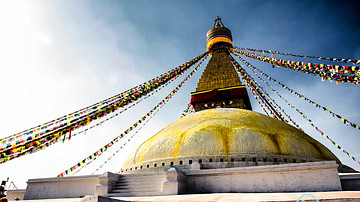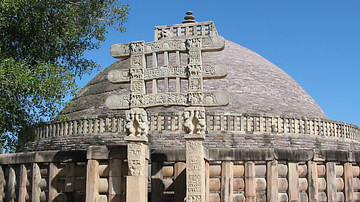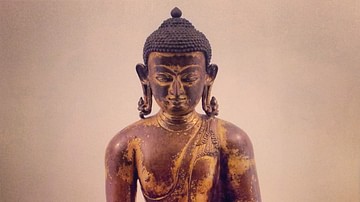A small carved figurine sits high on a grand multi-tiered pedestal in a magnificent wat (temple) in Bangkok, Thailand. It has been sitting there since 1784 CE and was originally thought to be made of emerald. Hundreds of tourists and pilgrims line up every day to view the figurine, and the Thai people believe it brings prosperity to their nation.
Before 1784 CE, the figurine travelled for hundreds of years throughout Sri Lanka, India, Cambodia, and Laos dispensing miracles. It was revered for its protective powers and it was believed that political legitimacy rested in the hands of the person who possessed the little statue.

It is a story of myth woven with historical fact, and we will discover that this figurine has very mysterious origins.
The Emerald Buddha
The figurine is called Phra Kaew Morakot in Thai. It is an image of the philosopher and spiritual teacher Siddharta Gautama who is more commonly known as the Buddha, and it shows him meditating while seated in the virasana yogic position and wearing fine gold cloth and diamonds. When the Buddha lived and died is a matter of scholarly debate, but there is agreement that he lived in northern India between the mid-6th and the mid-4th centuries BCE.
In English, the figurine is called the Emerald Buddha. It is 66 centimetres (26 inches) in height, 48.3 centimetres (19 inches) in width at the lap, and it is carved from a single piece of grey-green jasper found in Africa and India (not emerald as its name implies). The first-time visitor is usually surprised to see such a tiny Buddha perched high on a nine-metre (29.5 ft) pedestal that reaches almost to the ceiling in the ubosoth (ordination hall) where it is housed. The Buddha image is elevated above the heads of visitors because it is a sign of respect.

History does not tell us where the Emerald Buddha originated from nor does it tell us who carved it. The first historical reference to the figurine is its discovery in Chiang Rai in northern Thailand in 1434 CE when lightning cracked open the stucco wall of a chedi (bell-shaped Buddhist stupa) and revealed its hiding place.
Until this date, the figurine had a mystical past and much of what is known of its origin and travels comes from the Chronicle of the Emerald Buddha, written in the Pali language on a palm leaf manuscript found in Chiang Mai (northern Thailand) during the 15th century CE. The chronicle is largely fictitious so we must take it with a historical grain of salt. Events mentioned from the 15th century CE onwards are, however, historically accurate. The fable-like origins of the Emerald Buddha are the reason why it is thought to have spiritual power and is an extremely important icon to the Thai people.
The Legend of the Emerald Buddha
In 1932 CE, the Chronicle of the Emerald Buddha was translated into English by the French consul in Thailand, Camille Notton (c. 1881-1961 CE). There were many manuscripts about the Buddha image from neighbouring countries such as Cambodia and Laos. This points to the possibility that an older text existed, but the Chronicle is the version that tells us about the figurine's history.
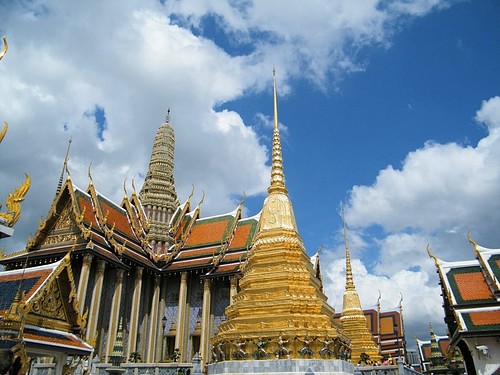
Later dating of the Buddha image indicates that it may have been crafted in the 15th century CE in the Kingdom of Lanna (northern Thailand) from stone brought from a quarry in China, although there are also theories that it originated in Sri Lanka.
The chronicles go on to tell us that in 457 CE, the king of Burma (Myanmar) requested the Buddha make the journey to his land to help promote Buddhism. After a successful mission, the ship carrying the Buddha image back to India lost its way and ended up in Cambodia. The little statuette sojourned for hundreds of years in Angkor Wat until King Anawrahta (r. 1044–77 CE) demanded its return to Burma, but the ruler of Angkor refused his request. The Luang Prabang Chronicles, which parallel the Chronicles of the Emerald Buddha, suggest that King Anawrahta disguised himself as a merchant to steal the Buddha image but failed in his mission.
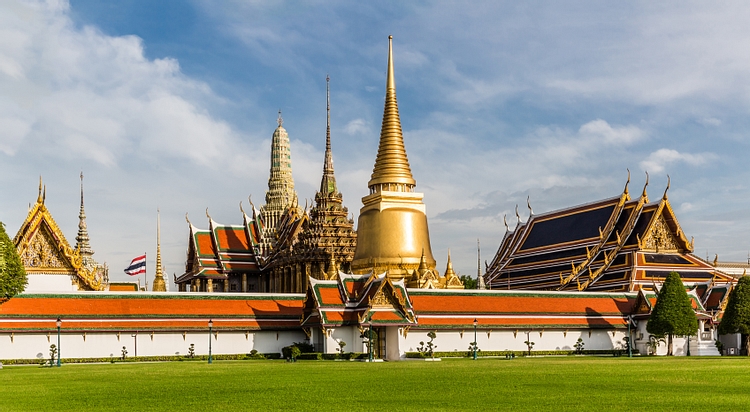
Thousands came to see the little statue that was said to have great spiritual powers. King Samfangkaen (r. 1402-1441 CE) of the Lanna kingdom in Chiang Mai ordered the Buddha be brought to his city in 1436 CE. It was placed on the back of an elephant, but it seemed the figurine had other ideas for the elephant became agitated and headed down the road to Lampang instead. A calmer elephant was then given the task of carrying the Buddha image but it too charged off towards Lampang.
King Samfangkaen decided that the Emerald Buddha did not wish to go to Chiang Mai. He allowed it to be housed in the Phra Keo temple in Lampang where it stayed until 1560 CE. Setthathirat I (1534-1571 CE), the king of Chiang Mai and Laos, then moved his capital along with the Emerald Buddha to Vientiane in Laos.
The figurine enjoyed a long sojourn of 250 years in Vientiane until 1778 CE when the Thai military commander, Taksin the Great (1734-1782 CE), captured the city and returned the Emerald Buddha to Thailand. Taksin took the Buddha image to Thonburi, which was the Thai capital for a short time after Ayutthaya was destroyed by the Burmese in 1767 CE. Thonburi was opposite modern-day Bangkok, on the western banks of the Chao Phraya River.
Taksin was said to be an arbitrary leader with royal pretensions and mental instability. He was overthrown and executed in 1782 CE by one of his top generals who became King Rama I (1737-1809 CE), founder of the Chakri dynasty, which is still the ruling royal house of Thailand.
Rama I named his capital Rattanakosin (present-day Bangkok). Rattanakosin in Thai means "keeping place of the Emerald Buddha", and it was here that the Buddha image found its permanent home in a grand temple built by Rama I to showcase the figurine. The Emerald Buddha was placed in its special wat in 1784 CE.
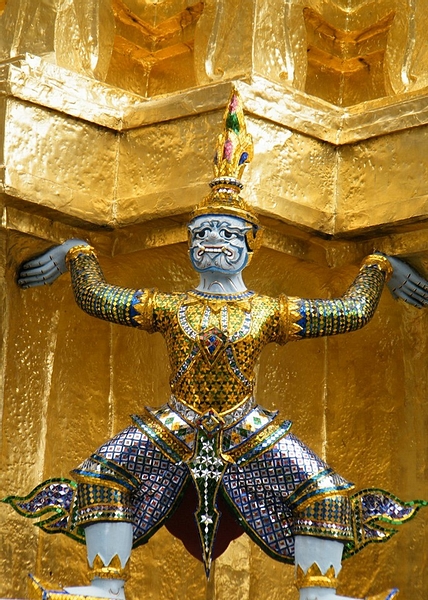
The mythical and historical past of the figurine highlights an important belief surrounding Buddha images. It is believed that they protected a monarch, their city or capital. If a king or prince was dethroned or defeated in battle, the Buddha image was taken as a hostage and kept in the capital of the victor in a subordinate position to that of the victor's Buddha image.
The Emerald Buddha spent hundreds of years journeying back and forth between countries, but it is now the powerful symbol of the Chakri ruling dynasty, and the Thai people believe it brings great fortune and protection to their country.
The Temple of the Emerald Buddha
The official name of the wat built to showcase the Buddha figurine is Phra Sri Rattana Satsadaram, but the Thai people call it Wat Phra Kaew. It is located on the grounds of the Grand Palace complex, which covers 213,677 square metres (2.3 million square feet) in the heart of Bangkok and is arguably the city's most impressive tourist attraction. There are over 100 sites in the complex for tourists to visit and they are all within the white perimeter wall of the complex.
Although there are over 40,000 Buddhist temples in Thailand, Wat Phra Kaew is the main Buddhist temple of the country and its spiritual importance can be compared to the Notre-Dame cathedral of Paris or the al-Haram mosque of Mecca.
The Grand Palace was constructed from wood and bricks that survived the destruction of Ayutthaya. Rama I ordered the floor plan to be the same as that of the Grand Palace at Ayutthaya so as to preserve something of the memory of the city that had been the Thai capital for 417 years.

The temple's exterior is an attraction in itself - orange, green and dark blue glazed roof tiles, golden gilt carvings, bronze tinkling bells, and glittering coloured mosaics. The wat is to the left after you enter the grounds of the Grand Palace through the Victory Gate and is largely as it appeared when built in 1784 CE.
It is in the northeast of the complex, and you enter the temple through wooden doors inlaid with mother-of-pearl illustrations from the Ramakien (Thailand's national epic). The ubosoth is a large rectangular space with the Emerald Buddha on a multi-tiered golden pedestal towards the back. The plinth (base) was added by King Rama III (r. 1824-51 CE). The proportion of the room with the small Buddha perched high reflects the symbolic importance of the figurine.
There are many other Buddha images in the temple. Two three-metre (9.8 ft) high Buddha statues sit on either side of the pedestal, and these are thought to personify the first two Chakri kings.

Six pairs of giant demon guardians flank all entrances to the wat. They are known as yaksha and are Buddhist gods that protect against evil spirits. In Thai, they are called yak (giant). The yaksha were placed there during the reign of Rama III.
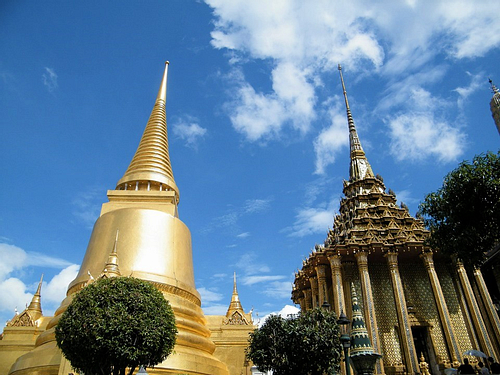
The Emerald Buddha & the King
The Temple of the Emerald Buddha plays a central role in the coronation of Thai kings. Thailand's present king is Maha Vajiralongkorn or Rama X (r. 2016-present), who is the first king in 69 years after succeeding his father Rama IX (1927-2016 CE). Ahead of his three-day coronation, Rama X paid respect to the Emerald Buddha by lighting a candle at 4.19 pm precisely - a time the royal court's astrologers considered auspicious.
Holy waters were taken by elaborate procession to the wat for the royal purification ceremony. And a golden plaque inscribed with the king's official name, horoscope, and royal seal was transferred from the temple to the Grand Palace.
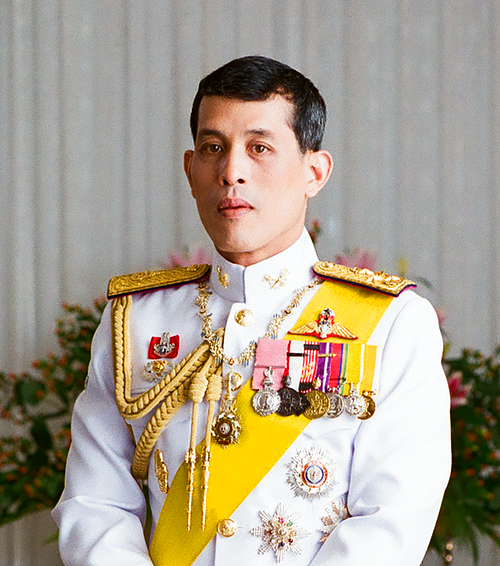
10 Fun Facts
1. In Wat Phra Kaew, you must sit with your feet pointing away from the Emerald Buddha as a sign of respect.
2. Three times a year, the Thai king climbs up a ladder behind the Buddha image and wipes the dust off the figurine before changing its clothes.
3. Only His Majesty the King may touch the Emerald Buddha because he is the designated protector of the Buddhist faith in Thailand.
4. Wat Phra Kaew does not contain living quarters for monks.
5. Another attraction at the wat is an exact replica of Angkor Wat, which was constructed during the reign of Rama IV when Cambodia was under Thai control.
6. In May 1992 CE, when there were protests against a perceived weakened democracy, Rama IX ordered General Suchinda Kraprayoon (the Prime Minister) to crawl on his knees in front of him to shame Suchinda publicly. The dramatic disgracing of the General signalled the immense power the king of Thailand wielded and derived from the Emerald Buddha.
7. Offerings to the Emerald Buddha are usually lilies and incense.
8. There are private viewing areas with screens for the royal family when they visit the Emerald Buddha.
9. Opening time is 8.30 am but tourists are often there by 8.00 am. Since the wat is a sacred place, you must dress appropriately - nothing revealing, no shorts, no sandals. Suitable clothing can be rented on site. If you are visiting during the hot season, take water with you because small bottles of water that you can buy on-site are expensive. You can buy tickets online from the website of the Grand Palace.
10. Silverware for state ceremonies and coronations are kept under the throne hall of the Grand Palace.
How to Get There
The Grand Palace complex is on Na Phra Lan Road, Bangkok. The best way to travel there is by the Chao Phraya River, and you can rent a Chao Phraya River express taxi (with orange flags) and alight at Tha Chang pier. After a 500-metre walk, you will see the Grand Palace on your right.
If you go by Skytrain (BTS) take the BTS to Saphan Taksin Station, Exit Two and follow the signs to the boat pier. Take the express taxi nine stops north to the Tha Chang (Elephant) pier. Then it is a short walk to the Grand Palace.
By subway or MRT, get off at Hua Lamphong Station, Exit Four. Then walk to the Bangkok Center Hotel and take bus number 25 or 53. Subway routes and information can be found here.
The Grand Palace complex is open daily from 8.30 am to 3.30 pm and the cost to farang (foreigners) is 500 Baht (USD 15.68). Remember to be respectful when taking photos of the temples, carvings, and statues. As photogenic as the Emerald Buddha may be, visitors are no longer allowed to take photos, but there are over 100 sites for you to explore in the complex to get those Instagram-worthy photos.


